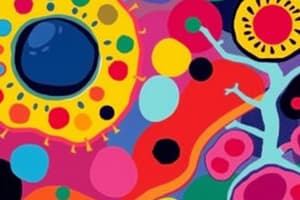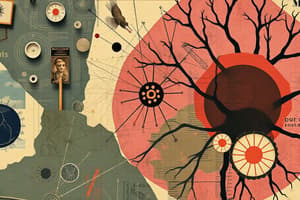Podcast
Questions and Answers
What is the basic structural and functional unit of all living organisms?
What is the basic structural and functional unit of all living organisms?
- Organ
- Organelle
- Tissue
- Cell (correct)
Which scientist is credited with observing living cells in 1674?
Which scientist is credited with observing living cells in 1674?
- Anton Van Leeuwenhoek (correct)
- Matthias Schleiden
- Theodor Schwann
- Robert Hooke
What did Rudolf Virchow propose regarding cells?
What did Rudolf Virchow propose regarding cells?
- Cells do not reproduce
- All plants are made up of cells
- All cells arise from pre-existing cells (correct)
- The cell is the basic unit of life
Which of the following is NOT a concept derived from cell theory?
Which of the following is NOT a concept derived from cell theory?
What did Felix Dujardin discover in 1835?
What did Felix Dujardin discover in 1835?
An organism composed of only one cell is known as a?
An organism composed of only one cell is known as a?
Who proposed that all plants are made up of cells?
Who proposed that all plants are made up of cells?
Which of the following statements is a part of cell theory?
Which of the following statements is a part of cell theory?
What is defined as a multicellular organism?
What is defined as a multicellular organism?
What is the size of the smallest known cell?
What is the size of the smallest known cell?
Which cell is known to be the largest in the human body?
Which cell is known to be the largest in the human body?
What shape do human red blood cells take, facilitating their function?
What shape do human red blood cells take, facilitating their function?
What instrument is typically used to study the detailed structure of a cell?
What instrument is typically used to study the detailed structure of a cell?
Which type of microscope can provide ultrastructural details of cells?
Which type of microscope can provide ultrastructural details of cells?
What variation of cell shape is primarily influenced by a cell's function?
What variation of cell shape is primarily influenced by a cell's function?
What characteristics differentiate species like Euglena and Amoeba from other cells?
What characteristics differentiate species like Euglena and Amoeba from other cells?
Which structure is responsible for encapsulating the cell and controlling the entry and exit of substances?
Which structure is responsible for encapsulating the cell and controlling the entry and exit of substances?
What is the main function of the nucleus in a cell?
What is the main function of the nucleus in a cell?
Which organelle is primarily involved in protein synthesis?
Which organelle is primarily involved in protein synthesis?
What is the function of mitochondria within a cell?
What is the function of mitochondria within a cell?
Which cellular structure is found only in plant cells and provides structural support?
Which cellular structure is found only in plant cells and provides structural support?
Which structure helps in the digestion of waste materials in the cell?
Which structure helps in the digestion of waste materials in the cell?
Which of the following organelles is responsible for modifying, sorting, and packaging proteins?
Which of the following organelles is responsible for modifying, sorting, and packaging proteins?
What is the main role of the vacuole in plant cells?
What is the main role of the vacuole in plant cells?
What is the primary function of chromoplasts in plant cells?
What is the primary function of chromoplasts in plant cells?
Which pigment is associated with tomatoes?
Which pigment is associated with tomatoes?
What is the primary food product stored in leucoplasts?
What is the primary food product stored in leucoplasts?
What are the two distinct regions found in chloroplasts?
What are the two distinct regions found in chloroplasts?
What structure in centrosomes is primarily responsible for forming spindle fibers during cell division?
What structure in centrosomes is primarily responsible for forming spindle fibers during cell division?
What are microtubules made of?
What are microtubules made of?
Which organelles are primarily involved in providing structural strength to the cell?
Which organelles are primarily involved in providing structural strength to the cell?
What function is specifically attributed to the stroma of chloroplasts?
What function is specifically attributed to the stroma of chloroplasts?
Which of the following is NOT a role of centrioles?
Which of the following is NOT a role of centrioles?
What is the main function of chlorophyll found in thylakoids?
What is the main function of chlorophyll found in thylakoids?
What is the primary function of the plasma membrane?
What is the primary function of the plasma membrane?
Which of the following structures is responsible for protein synthesis?
Which of the following structures is responsible for protein synthesis?
Which cell organelle is known as the powerhouse of the cell?
Which cell organelle is known as the powerhouse of the cell?
What type of genetic material is primarily stored in chromosomes?
What type of genetic material is primarily stored in chromosomes?
What is the main structural component of the cell wall in plants?
What is the main structural component of the cell wall in plants?
What does the cytoplasm primarily consist of?
What does the cytoplasm primarily consist of?
Which part of the nucleus is responsible for synthesizing ribonucleic acid (RNA)?
Which part of the nucleus is responsible for synthesizing ribonucleic acid (RNA)?
What is the function of lysosomes in a cell?
What is the function of lysosomes in a cell?
Which component of the endoplasmic reticulum lacks ribosomes?
Which component of the endoplasmic reticulum lacks ribosomes?
What is the primary function of vacuoles in plant cells?
What is the primary function of vacuoles in plant cells?
What is a key characteristic of the Golgi body?
What is a key characteristic of the Golgi body?
Which part of the mitochondria is folded to form cristae?
Which part of the mitochondria is folded to form cristae?
What is the function of the nuclear pores?
What is the function of the nuclear pores?
In which type of cells are contractile vacuoles typically found?
In which type of cells are contractile vacuoles typically found?
Study Notes
Cell: The Fundamental Unit of Life
- Cells are the basic structural and functional units of all living organisms.
- All known living organisms are made up of one or more cells.
- The cell theory states that all living cells arise from pre-existing cells by division.
Key Figures in Cell Theory
- 1674: Anton Van Leeuwenhoek observed the first living cells.
- 1665: Robert Hooke discovered the cell.
- 1835: Felix Dujardin discovered fluid content in cells.
- 1839: J.E. Purkinje named the fluid content protoplasm.
- 1838: Matthias Schleiden proposed that all plants consist of cells.
- 1845: Carl Heinrich Braun suggested that the cell is the basic unit of life.
- 1855: Rudolf Virchow proposed that all cells arise from pre-existing cells.
Types of Organisms
- Unicellular organisms consist of a single cell (e.g., Euglena, Paramecium, Yeast).
- Multicellular organisms are composed of multiple cells (e.g., Plants, Animals, Fungi).
Cell Sizes
- Smallest cell: Mycoplasma, measuring 0.1 µm.
- Largest cell: Ostrich egg, measuring 18 cm.
- Human cells vary:
- Smallest: Sperm cell, 5 µm.
- Largest: Ovum cell, 120 µm.
- Longest: Nerve cell, 1 m.
Cell Shape
- Human red blood cells are circular and biconcave for efficient capillary passage.
- Nerve cells have branched shapes to conduct impulses.
- Some cells can alter their shape, while others maintain a fixed structure.
Cell Structure
- Common features in most cells: plasma membrane, nucleus, and cytoplasm.
- Plasma membrane is semi-permeable, maintaining cell homeostasis and protecting contents.
- Cell wall (non-living) provides structure, strength, and rigidity in plants and bacteria.
Nucleus
- Central dense body, usually 10-25 µm in diameter, found in most cells.
- Contains nuclear membrane with pores, nucleoplasm, nucleolus, and chromatin fibers (DNA and proteins).
- Controls cell activities, including metabolism, growth, and replication, through gene expression.
Cytoplasm
- jelly-like substance made of 80% water, containing cytosol and various organelles.
- Organelles include ribosomes, endoplasmic reticulum (smooth and rough), Golgi body, lysosomes, vacuoles, and mitochondria.
Organelles
- Endoplasmic Reticulum (ER): Network linked to the nuclear and cell membranes, includes rough ER (with ribosomes for protein synthesis) and smooth ER (involved in lipid synthesis and detoxification).
- Golgi Body: Stacks of membranes modifying and sorting materials from the ER for transport within or outside the cell.
- Lysosomes: Membrane-bound sacks filled with enzymes for digesting large molecules, pathogens, and worn-out organelles.
- Vacuoles: Storage sacs for liquids; larger in plant cells for turgidity, smaller and temporary in animal cells.
- Mitochondria: Double membrane-bound organelles involved in energy production (ATP synthesis).
Plastids
- Double membrane-bound organelles found in plants and certain algae, involved in storage and photosynthesis.### Plastids
- Plastids are organelles responsible for the synthesis and storage of food.
- Chromoplasts produce pigments affecting the color of cells.
- Example: Carrots contain carotene; mangoes contain xanthophyll; tomatoes contain lycopene.
- Leucoplasts are colorless plastids that store food such as starch, protein, and oil.
- Found in organs like tubers and seeds (e.g., potato tubers, maize grains, castor seeds).
Chloroplasts
- Chloroplasts are double membrane-bound organelles predominantly in plant cells.
- Characterized by a spherical or discoidal shape with two distinct regions: grana and stroma.
- Grana consist of stacks of thylakoids, which house chlorophyll molecules essential for photosynthesis.
- Stroma is the dense, colorless fluid where important reactions occur.
- Functions include:
- Converting light energy into chemical energy stored as food.
- Providing the green color in leaves, stems, and vegetables.
Centrosome
- The centrosome is a membrane-bound organelle located near the nucleus.
- Contains two centrioles arranged perpendicularly, made of microtubules.
- Functions:
- Forming spindle fibers that facilitate chromosome movement during cell division.
- Assisting in the development of cilia and flagella.
Cytoskeleton
- The cytoskeleton is composed of microtubules and microfilaments.
- Microtubules are hollow tubes made of tubulin, while microfilaments are thin rods made of actin.
- Functions include:
- Determining and maintaining cell shape.
- Providing structural strength.
- Enabling cellular movements.
Cell Types
- Prokaryotic cells lack a membrane-bound nucleus and organelles.
- Eukaryotic cells possess a membrane-bound nucleus and complex organelles.
Studying That Suits You
Use AI to generate personalized quizzes and flashcards to suit your learning preferences.
Related Documents
Description
Explore the fascinating world of cells, the building blocks of life. This quiz covers key figures in cell theory, types of organisms, and the significance of cells in living organisms. Test your knowledge of cellular structure and function.




